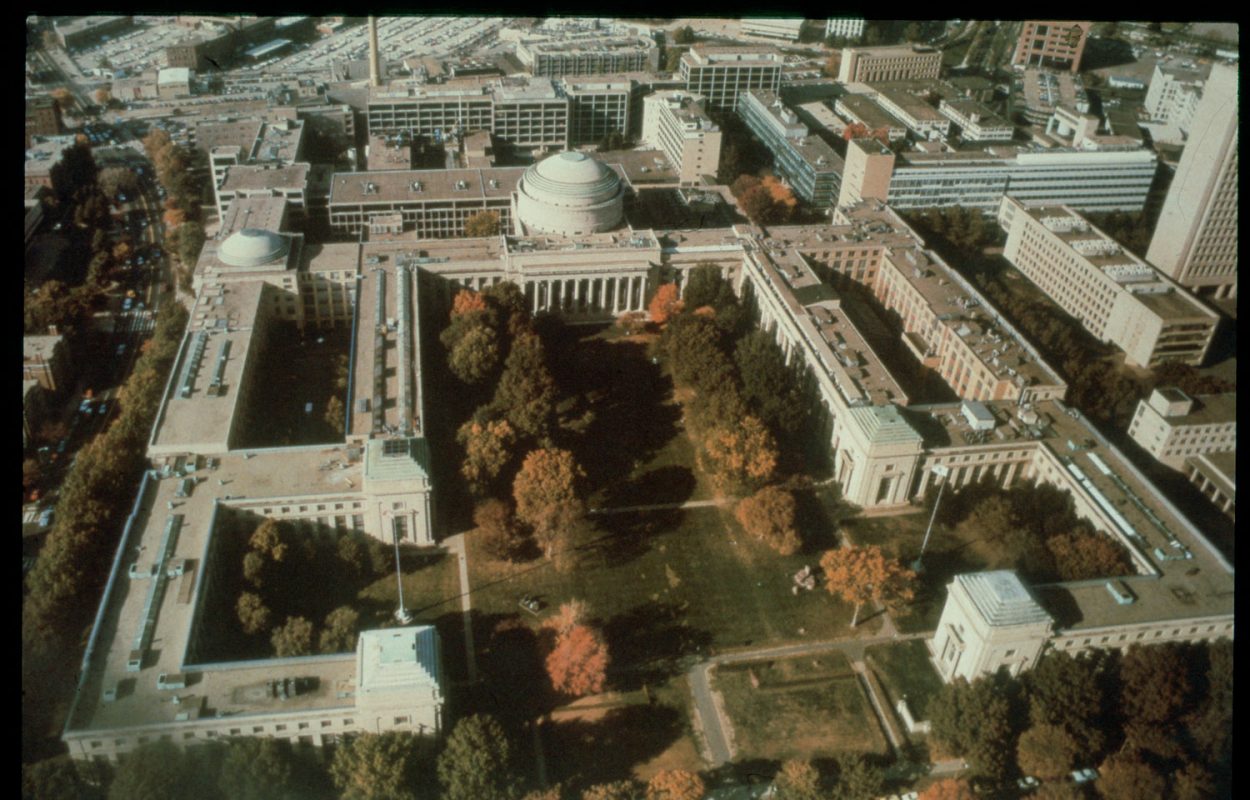Signers of the 1861 “Act of Association”
MIT’s first president, William Barton Rogers was a noted geologist and educator who had a vision for a new educational model. Rogers began to organize and promote his ideas for a “polytechnic” institute as early as the 1840s and particularly in Massachusetts after Rogers moved to Boston in 1853. Among the documents that led to the Institute’s incorporation on April 10, 1861, is a January 11, 1861 “Act of Association” that was adopted and signed by supporters of the plan to establish the Massachusetts Institute of Technology. This group, comprised of 37 prominent New England figures, united under their “deep interest in promoting the Industrial Arts and Sciences as well as practical education.” By signing the document, they officially associated themselves with the eventual establishment of the Institute and pledged their hearty approval.
The “Act of Association” hand-written by Rogers is transcribed below:
“We the subscribers, feeling a deep interest in promoting the Industrial Arts and Sciences as well as practical education, heartily approve the objects and plan of an Institute of Technology embracing a Society of Arts, a Museum of Arts, and a School of Industrial Science, as set forth in the Report of ‘the Committtee of Associated Institutions,’ etc., and we hereby associate ourselves for the purpose of endeavoring to organize and establish in the city of Boston such an Institution under the title of the Massachusetts Institute of Technology, whensoever we may be legally empowered and properly prepared to carry these objects into effect.”
The January 11, 1861 meeting in Mercantile Hall on Summer Street in Boston is described in Chapter VIII, pages 60-64 of Life and Letters of William Barton Rogers.
Some signers went on to become members of the original MIT Corporation, and others became lecturers, faculty, or administrators. Many others lent a hand in the establishment of the Institute in other ways; some donated money, some volunteered their skills, and some used their influence. The location of MIT’s original campus, Boston’s newly filled Back Bay, was largely a result of a few signers’ hard work and prominence within the city.
These biographical sketches were researched and composed during the summer of 2017. In addition to photographs, when found, and basic biographical information, some sketches include ancestral information and evidence of connections with the Atlantic slave trade.
Francis Alger
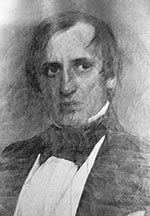 Francis Alger was born in Boston, Massachusetts, on March 8, 1807, the son of the wealthy metallurgist Cyrus Alger. Never having advanced past a common school education, Alger devoted his free time to the independent study of mineralogy. He was especially interested in that of Nova Scotia and New Jersey, and continued to collect samples from and publish studies on those locations throughout his life. After publishing several successful articles and amassing a rich private collection of minerals, he received an honorary M.A. from Harvard in 1849.
Francis Alger was born in Boston, Massachusetts, on March 8, 1807, the son of the wealthy metallurgist Cyrus Alger. Never having advanced past a common school education, Alger devoted his free time to the independent study of mineralogy. He was especially interested in that of Nova Scotia and New Jersey, and continued to collect samples from and publish studies on those locations throughout his life. After publishing several successful articles and amassing a rich private collection of minerals, he received an honorary M.A. from Harvard in 1849.
After his father’s death in 1856, Alger took over as manager of the South Boston Iron Company. The company flourished during the Civil War, during which it aided in supplying the U.S. government with cannons and projectiles. A lifelong supporter of the sciences, Alger was a member of the American Academy of Arts and Sciences as well as the Curator of Mineralogy for the Boston Society of Natural History. He passed away in Washington, D.C., on November 27, 1863.
Incorporators of the Massachusetts Institute of Technology, MIT Institute Archives and Special Collections, c.1920, pg. 1
A genealogical history of that branch of the Alger family which springs from Thomas Alger of Taunton and Bridgewater, in Massachusetts. 1665-1875 by Arthur M. Alger
“Obituary – Francis Alger,” The American Journal of Science, vol. 88, (1864), pg. 449
Andrew Bigelow
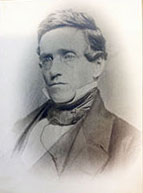 Andrew Bigelow was born in Groton, Massachusetts, on May 7, 1795. After graduating from Harvard in 1814 and Harvard Divinity School in 1817, Bigelow began working on a law degree but soon abandoned it in favor of entering the Christian ministry. From there, he continued his study of theology at the University of Edinburgh before earning a Doctorate of Sacred Theology from Harvard in 1844. Between the years of 1820 and 1844 Bigelow settled several churches across the states of Massachusetts and Maine before becoming the minister of the same Unitarian Church in Washington D.C. attended by John Quincy Adams during his presidency.
Andrew Bigelow was born in Groton, Massachusetts, on May 7, 1795. After graduating from Harvard in 1814 and Harvard Divinity School in 1817, Bigelow began working on a law degree but soon abandoned it in favor of entering the Christian ministry. From there, he continued his study of theology at the University of Edinburgh before earning a Doctorate of Sacred Theology from Harvard in 1844. Between the years of 1820 and 1844 Bigelow settled several churches across the states of Massachusetts and Maine before becoming the minister of the same Unitarian Church in Washington D.C. attended by John Quincy Adams during his presidency.
In addition to his work as a minister, Bigelow acted as President of the Massachusetts Temperance Society in 1813 as well as a member of the American Antiquarian Society. He also aided in the organization of the Boston Homes for Aged Men and Women. Bigelow passed away in Boston, Massachusetts, on April 1, 1881.
Incorporators of the Massachusetts Institute of Technology, MIT Institute Archives and Special Collections, c.1920, pg. 4
New England Historic Genealogical Register vol. 31, pg. 132
Thomas Boyd
 Thomas Boyd was born in Newtonards, Ireland, on August 10, 1808, and relocated to Boston with his family as a young boy. Boyd grew up as an apprentice carpenter in Boston, and went on to start his own business at a relatively young age. According to the records of the Massachusetts Charitable Mechanics Association, of which he was a lifetime member, Boyd was one of the first Boston-based carpenters to employ the use of steam power in his work. Throughout his life, he designed and erected many buildings and structures throughout the United States, most notably the United States Mint located in San Francisco, California. In his early years Boyd was also a volunteer firefighter in Boston, and later in life, a member of the Masonic and Odd Fellows fraternities. He passed away on August 25, 1887, at his home in Cambridge, Massachusetts.
Thomas Boyd was born in Newtonards, Ireland, on August 10, 1808, and relocated to Boston with his family as a young boy. Boyd grew up as an apprentice carpenter in Boston, and went on to start his own business at a relatively young age. According to the records of the Massachusetts Charitable Mechanics Association, of which he was a lifetime member, Boyd was one of the first Boston-based carpenters to employ the use of steam power in his work. Throughout his life, he designed and erected many buildings and structures throughout the United States, most notably the United States Mint located in San Francisco, California. In his early years Boyd was also a volunteer firefighter in Boston, and later in life, a member of the Masonic and Odd Fellows fraternities. He passed away on August 25, 1887, at his home in Cambridge, Massachusetts.
Incorporators of the Massachusetts Institute of Technology, MIT Institute Archives and Special Collections, c.1920, pg. 6 (written from information provided by his daughter, Fannie Boyd)
Annals of the Massachusetts Charitable Mechanic Association vol. 1, pg. 483
Charles Allen Browne
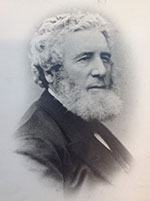 Charles Allen Browne was born in Salem, Massachusetts, on June 6, 1812. He was a druggist and medicine merchant in Boston, as well as an active member of the Boston Association for the Relief of Aged Indigent Females. He passed away in Boston on March 1, 1893.
Charles Allen Browne was born in Salem, Massachusetts, on June 6, 1812. He was a druggist and medicine merchant in Boston, as well as an active member of the Boston Association for the Relief of Aged Indigent Females. He passed away in Boston on March 1, 1893.
Incorporators of the Massachusetts Institute of Technology, MIT Institute Archives and Special Collections, c.1920, pg. 7
Obituary, Boston Transcript on 4 March, 1893
“In Memorium,” Annual Report of the Association for the Relief of Aged Indigent Females, vol. 35, pg. 45
David Bryant
David Bryant was born on January 8, 1801, in Bradford, New Hampshire. After beginning his career in Quincy as a carpenter, he moved to Boston and climbed within the trade from carpenter to architect to surveyor to superintendent. His most well-known work was the remodeling and repurposing of Boston’s Province House into a theater in 1852. Built in 1679, the 17th-century mansion belonged to a merchant before becoming the official residence for the governors of the Province of Massachusetts. The newly remodeled theater was renamed Ordway Hall and became known for black minstrel shows.
Mr. Bryant was an active member of the Bulfinch Street Church Choir as well as a member of the New England Historic Genealogical Society. He passed away in Palmer, Massachusetts, on September 24, 1867.
A genealogy of the Bryant and other associated families is available at the Massachusetts Historical Society. These records indicate that the Bryant family owned slaves during the 1600s and early 1700s, but all mentions cease after around 1750. This information was gleaned from accounts of the family’s changes in property during a move.
Incorporators of the Massachusetts Institute of Technology, MIT Institute Archives and Special Collections, c.1920, pg. 8
New England Historic Genealogical Register, vol. 22 pg. 475
Bryant-Mason-Smith Family Papers, Massachusetts Historical Society, (box 4, folder 6-7)
William E. Coale
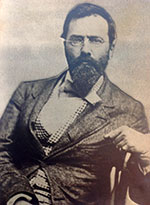 William E. Coale was born in Baltimore, Maryland, on February 7, 1816. His father, Edward J. Coale, was a bookbinder. William Coale earned his M.D. from the University of Maryland in 1836, and later was awarded an honorary A.M. from Trinity College in 1860. He dedicated his life to medicine, from his start as a physician at the Baltimore General Dispensary to his work from the 1840s until the end of his life as a general practitioner and medical instructor in Boston. Coale also spent time working as a hospital inspector for the U.S. Sanitary Commission and was active in the Massachusetts Medical Society, the Scots Charitable Society of Boston, and the Church of the Advent.
William E. Coale was born in Baltimore, Maryland, on February 7, 1816. His father, Edward J. Coale, was a bookbinder. William Coale earned his M.D. from the University of Maryland in 1836, and later was awarded an honorary A.M. from Trinity College in 1860. He dedicated his life to medicine, from his start as a physician at the Baltimore General Dispensary to his work from the 1840s until the end of his life as a general practitioner and medical instructor in Boston. Coale also spent time working as a hospital inspector for the U.S. Sanitary Commission and was active in the Massachusetts Medical Society, the Scots Charitable Society of Boston, and the Church of the Advent.
During the Civil War, Coale ran the James River hospital transport until ill health forced him to retire, likely due to repeated exposure to malaria during his hospital visits for the Sanitary Commission. After succumbing to several health issues, Dr. Coale died in Boston on April 27, 1865. Shortly after his death, Dr. George C. Shattuck published a detailed account of the medical issues leading to Coale’s death. The account was later read before the Boston Society for Medical Improvement and published in the Boston Medical and Surgical Journal.
Incorporators of the Massachusetts Institute of Technology, MIT Institute Archives and Special Collections, c.1920, pg. 11 (Bio adapted from statement given by son (O.G. Coale))
“An Account of Some of the Symptoms and Lesions in the Case of Dr. William E. Coale, of Boston – Read before the Boston Society for Medical Improvement, and Communicated for the Boston Medical and Surgical Journal,” Boston Medical and Surgical Journal, vol. 72, pg. 374.
James Cogswell Converse
 Born in Weathersfield, Vermont, on September 23, 1807, James Cogswell Converse decided to forego a college education in favor of an occupation as a dry goods merchant in Boston. He worked for several dry goods firms in the Boston area, eventually developing partnerships and becoming a senior member of the wholesale merchant business Converse, Blanchard, and Company. During this period he was also involved in the establishment of several steamship lines across the East Coast and South including the Baltimore and Norfolk Steamship Company, the Merchants Boston and New Orleans Steamship Company, and the American Steamship Company. Converse also acted as the Director and President of the Boston Board of Trade, as Director of the Troy and Greenfield Railroad, as President of the National Tube Works, and as the first-ever Chairman of the Massachusetts Board of Railroad Commissioners, established in 1871. He kept a summer home in Greenfield, Massachusetts, where he passed away on May 23, 1891.
Born in Weathersfield, Vermont, on September 23, 1807, James Cogswell Converse decided to forego a college education in favor of an occupation as a dry goods merchant in Boston. He worked for several dry goods firms in the Boston area, eventually developing partnerships and becoming a senior member of the wholesale merchant business Converse, Blanchard, and Company. During this period he was also involved in the establishment of several steamship lines across the East Coast and South including the Baltimore and Norfolk Steamship Company, the Merchants Boston and New Orleans Steamship Company, and the American Steamship Company. Converse also acted as the Director and President of the Boston Board of Trade, as Director of the Troy and Greenfield Railroad, as President of the National Tube Works, and as the first-ever Chairman of the Massachusetts Board of Railroad Commissioners, established in 1871. He kept a summer home in Greenfield, Massachusetts, where he passed away on May 23, 1891.
Incorporators of the Massachusetts Institute of Technology, MIT Institute Archives and Special Collections, c.1920, pg. 12 (Bio “adapted from a Boston Newspaper Notice” from 24 May 1891)
“Memorial Biographies of the New England Historic Genealogical Society,” Towne Memorial Fund, New England Historic Genealogical Society, 1908, pg. 47
Robert Morris Copeland
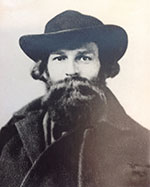 Robert Morris Copeland was born in Roxbury, Massachusetts, on December 11, 1830. As a landscape gardener partnered with Horace Cleveland, he was best known for his cemetery plans. During his career Copeland designed sites including New York’s Sleepy Hollow Cemetery in 1855, and, in 1866, Oak Bluffs on Martha’s Vineyard, one of the United States’ first planned residential communities. He was described by peers and contemporaries as ambitious and a visionary within his field. In his book Country Life: A Handbook of Agriculture, Horticulture, and Landscape Gardening he writes critically of Boston Common, calling it “mutilated” due to missed aesthetic opportunities and discussing the choices he would have made to improve it.
Robert Morris Copeland was born in Roxbury, Massachusetts, on December 11, 1830. As a landscape gardener partnered with Horace Cleveland, he was best known for his cemetery plans. During his career Copeland designed sites including New York’s Sleepy Hollow Cemetery in 1855, and, in 1866, Oak Bluffs on Martha’s Vineyard, one of the United States’ first planned residential communities. He was described by peers and contemporaries as ambitious and a visionary within his field. In his book Country Life: A Handbook of Agriculture, Horticulture, and Landscape Gardening he writes critically of Boston Common, calling it “mutilated” due to missed aesthetic opportunities and discussing the choices he would have made to improve it.
Copeland was an eager participant in the war effort, climbing from the rank of Quartermaster of the 2nd Massachusetts Regiment to that of aide-de-camp to General Nathaniel P. Banks in 1861. Copeland was also a passionate abolitionist, and traveled to Washington D.C. to appeal alongside Robert Gould Shaw for the establishment of black regiments during the Civil War. Due to a series of events and exchanges in which he inadvertently insulted the U.S. Secretary of War, Copeland was dishonorably discharged from the army in 1862. Having been denied a hearing, Copeland was confused as to the reason for his dismissal and, after various appeals failed, published a 52-page pamphlet on the events leading up to the situation. Friends of Copeland also wrote protests of his dismissal to President Abraham Lincoln and U.S. Senator Charles Sumner, some of which are now held at the Massachusetts Historical Society. Copeland was not formally acquitted until 1870. He died in Cambridge just four years later on March 28, 1874 after discovering that he had bone cancer while visiting the doctor for a broken arm.
A genealogy of the Copeland family is held at the Massachusetts Historical Society. Reverend Jonathan Copeland, a relative born slightly earlier in 1816, was also an abolitionist. While living in Kansas he delivered many antislavery and temperance sermons, and worked as a missionary alongside freed slaves.
Incorporators of the Massachusetts Institute of Technology, MIT Institute Archives and Special Collections, c.1920, pg. 13
Tisher, William H., “Introduction to the Reprint Edition,” Country Life: A Handbook of Agriculture, Horticulture, and Landscape Gardening, University of Massachusetts Press in association with LALH, 2009
Copeland, Robert Morris, “Statement of R. Morris Copeland, Asst. Adjutant-General and Major of Volunteers, discharged from service August 6, 1862,” Massachusetts Historical Society
Letters to Lincoln and Sumner from friends of Copeland protesting his dismissal, Massachusetts Historical Society
Copeland genealogy, Massachusetts Historical Society
Charles Henry Dalton
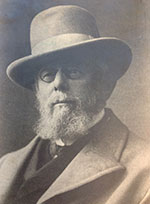 Charles Henry Dalton, the younger brother of John Call Dalton, was born in Chelmsford, Massachusetts, on September 25, 1826. Dalton served as Treasurer of the MIT Incorporators and went on to become a member of the MIT Corporation. The Dalton family first settled in the United States in the mid-1700s, during which James Dalton (born 1718) worked from Boston as the captain of the trading Brigantine “Joshua.” Dalton later expanded his business to include trade routes between the Carolinas, the West Indies, and Europe.
Charles Henry Dalton, the younger brother of John Call Dalton, was born in Chelmsford, Massachusetts, on September 25, 1826. Dalton served as Treasurer of the MIT Incorporators and went on to become a member of the MIT Corporation. The Dalton family first settled in the United States in the mid-1700s, during which James Dalton (born 1718) worked from Boston as the captain of the trading Brigantine “Joshua.” Dalton later expanded his business to include trade routes between the Carolinas, the West Indies, and Europe.
Charles Henry Dalton decided to forego college in favor of work, and his aptitude for business aided him in climbing quickly to prominence. As such he acted as an officer for a wide range of New England-based companies and organizations throughout his life. He was treasurer of the Manchester Print Works, Great Falls Manufacturing Company, and the Merrimac Manufacturing Companies, president of the Massachusetts General Hospital, Cumberland Coal Company, and Legal Aid Society, vice president of the New England Trust Company, Provident Institution for Savings, and Arkuright Club, director of the Massachusetts Hospital Life Insurance Company and Suffolk Bank, chairman of the Boston Park Commission, and a member of the Massachusetts Historical Society, Union Club, Sanitary Commission, and the Boston Transit Commission.
During the Civil War, Dalton was appointed Agent of the Commonwealth of Massachusetts at Washington. This followed a failed attempt to get involved in the war as an advisor to President Lincoln, which Dalton sold as an opportunity to use his presence “to help quell a disturbance” should one arise in Washington. Still, he was determined to lend a hand, being what his contemporaries called an “ardent Northerner.” Dalton’s work as Agent of the Commonwealth consisted chiefly in handling matters relating to distribution of supplies to troops, and his services greatly helped the war effort. After his stint in D.C. ended, Dalton briefly considered applying for a post on the war front itself. However, out of worry that he would not be chosen, he instead ceased his involvement with the Civil War altogether. Later in life, Dalton established the Dalton Graduate Chemical Scholarship Fund ($5000) at MIT in 1896. The grant was made especially for students looking to apply chemistry to the textile industry. He passed away in Boston on February 23, 1908. His Civil War correspondence with his brother can be found at the Massachusetts Historical Society.
Incorporators of the Massachusetts Institute of Technology, MIT Institute Archives and Special Collections, c.1920, pg. 14
Merriman, Roger Bigelow, “Memoir of Charles Henry Dalton,” Proceedings of the Massachusetts Historical Society, vol. 42, 1908-1909, pg. 287
Charles Henry Dalton Correspondence, Massachusetts Historical Society
John Call Dalton
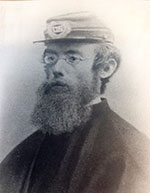 The older brother and role model of Charles Henry Dalton, John Call Dalton was born in Chelmsford, Massachusetts, on February 2, 1825. Following in his family’s tradition, Dalton trained as a doctor. He graduated from Harvard and Harvard Medical School in 1844 and 1847, respectively. Later in life, he also received honorary doctorates from Princeton and from Columbia.
The older brother and role model of Charles Henry Dalton, John Call Dalton was born in Chelmsford, Massachusetts, on February 2, 1825. Following in his family’s tradition, Dalton trained as a doctor. He graduated from Harvard and Harvard Medical School in 1844 and 1847, respectively. Later in life, he also received honorary doctorates from Princeton and from Columbia.
Dalton concentrated his studies on physiology and rapidly attained distinction in the field. He introduced to the United States the concept of instruction through the humane experimentation on live animals under anesthesia and authored A Treatise on Human Physiology, which would become a standard text in the field. In addition to his fieldwork, Dalton was Professor of Physiology at the University of Buffalo and the College of Physicians and Surgeons of New York. He also lectured at Vermont Medical College and Long Island College Hospital. While acting as an assistant surgeon for the New York State Militia’s Seventh Regiment during the Civil War, Dalton was commissioned as Surgeon of Volunteers and Medical Corps under Brigadier General Egbert L. Viele in 1861.
While traveling during the war he wrote detailed narratives on the various regions and forts he visited, some of which are published and others preserved in correspondence between Dalton and his brother. These writings included descriptions of military sites and activity, southern slavery, and more. Malaria forced Dalton to return home from the war, where he taught at and eventually became president of the College of Physicians and Surgeons of New York until the end of his life. He died in New York , New York on February 12, 1889. His Civil War correspondence with his brother can be found at the Massachusetts Historical Society.
Incorporators of the Massachusetts Institute of Technology, MIT Institute Archives and Special Collections, c.1920, pg. 15
Department of Veterans’ Affairs Medical Center, “John Call Dalton, Jr., MD: America’s first neurophysiologist,” US National Library of Medicine National Institutes of Health
Charles Henry Dalton Correspondence, Massachusetts Historical Society
Dalton, John Call, John Call Dalton, M.D., U.S.V., Riverside Press, Cambridge, MA, 1892
Ezekiel B. Elliott
E.B. Elliott was born in Sweden, New York, on July 16, 1823. He graduated from Hamilton College in 1844 specializing in mathematics, astronomy, and physics. Elliott spent a few years teaching before opening an “actuary and electrician” office in Boston. In his early years he focused more exclusively on the latter profession, working with telegraph companies to extend service into the East Coast by opening a line between Boston and New York City in 1849. In 1853 he was awarded a medal by the Massachusetts Charitable Mechanics Association for his invention of the white flint telegraph insulator. White flint was one of the stronger nonconductive materials available at the time, and it was preferable due to its resistance to fractures. Elliott’s other notable inventions include a portable dynamo, an electric motor, an electricity storing device, and an “auroral telephone.”
From 1855 on, Elliott delved deeper into actuarial work, completing projects for New England Mutual and the Massachusetts Secretary of State. During the Civil War, Elliott devoted himself wholeheartedly to working for the United States Sanitary Commission, dealing with statistics relating to casualties. His “Preliminary Report on the Mortality and Sickness of the Volunteer Forces of the US Government during the Present War” led to his election as a fellow of the American Academy of Arts and Sciences as well as Actuary to the Sanitary Commission. In 1881, Elliott was appointed as the first-ever United States Government Actuary, and in 1882, as Vice President of the American Association for the Advancement of Science. He passed away in Washington, D.C., on May 24, 1888.
“Ezekiel Brown Elliott,” Proceedings of the American Academy of Arts and Sciences, Vol. 24 (May, 1888 – May, 1889), pp. 447-452
Robert J. Myers, “The First United States Government Actuary and His Successors,” Transactions of the Society of Actuaries, vol. 6 no. 16, 1954, pg. 488
Charles William Folsom
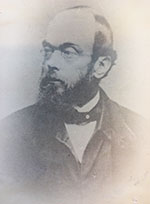 Charles William Folsom, a civil engineer, was born in Cambridge, Massachusetts, on April 17, 1817. After graduating from Harvard in 1845, he worked in the sewer division of the engineering department of the City of Boston, as Principal Assistant Engineer on a Southern railroad, and as an engineer for the Massachusetts State Commission on Drainage and Water Supply of the Charles and Neponset Rivers. During the Civil War, Folsom served as Quartermaster of the 20th Massachusetts Volunteer Regiment and was honorably discharged. Later in life, he ran the United States Department of National Cemetery and acted as Superintendent of Mount Auburn Cemetery. He was also a member of the Boston Civil Society of Engineers, Massachusetts Military Historical Society as well as Secretary of the Appalachian Mountain Club. He passed away on May 19, 1904, in Cambridge.
Charles William Folsom, a civil engineer, was born in Cambridge, Massachusetts, on April 17, 1817. After graduating from Harvard in 1845, he worked in the sewer division of the engineering department of the City of Boston, as Principal Assistant Engineer on a Southern railroad, and as an engineer for the Massachusetts State Commission on Drainage and Water Supply of the Charles and Neponset Rivers. During the Civil War, Folsom served as Quartermaster of the 20th Massachusetts Volunteer Regiment and was honorably discharged. Later in life, he ran the United States Department of National Cemetery and acted as Superintendent of Mount Auburn Cemetery. He was also a member of the Boston Civil Society of Engineers, Massachusetts Military Historical Society as well as Secretary of the Appalachian Mountain Club. He passed away on May 19, 1904, in Cambridge.
Incorporators of the Massachusetts Institute of Technology, MIT Institute Archives and Special Collections, c.1920, pg. 19
Obituary, Cambridge Tribune
Ezra Stiles Gannett
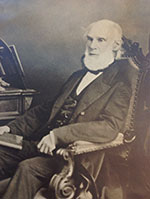 Ezra Stiles Gannett, a minister, was born in Cambridge, Massachusetts, on May 4, 1801. He graduated from Harvard in 1820 and Harvard Divinity School in 1823, and in 1843 he received an honorary S.T.D. degree from Harvard. He was ordained at the Arlington Street Church, formerly on Federal Street, and remained a minister there until his death.
Ezra Stiles Gannett, a minister, was born in Cambridge, Massachusetts, on May 4, 1801. He graduated from Harvard in 1820 and Harvard Divinity School in 1823, and in 1843 he received an honorary S.T.D. degree from Harvard. He was ordained at the Arlington Street Church, formerly on Federal Street, and remained a minister there until his death.
A deeply moral and spiritual man, Gannett was invested in many issues of the time including temperance, peace, spiritual and moral welfare, and slavery. He aided in the founding of the American Unitarian Association as well as the Benevolent Fraternity of Churches. He also wrote extensively on his beliefs and opinions in the form of sermons and discourses. On the subject of the Civil War, his leanings were always toward peace; he despised slavery itself as an abhorrent evil, but so hated violence and the idea of secession that he often butted heads with abolitionists. Often his writings reflected the conflict between his disdain for the institution of slavery and his deep respect for the law. Still, he wrote extensively and adjusted his views as the conflict evolved.
On April 26, 1871, Gannett died suddenly in the famous “Revere Disaster” on the Eastern Railroad. The catastrophic train wreck, a result of overcrowding and outdated equipment, involved the collision of a local and express train as they crossed paths at the Revere, Massachusetts, train station. The crash resulted in the deaths of 29 passengers.
Incorporators of the Massachusetts Institute of Technology, MIT Institute Archives and Special Collections, c.1920, pg. 21
Bradlee, Francis Boardman Crowninshield, The Eastern Railroad: A Historical Account of Early Railroading in Eastern New England, Essex Institute, 1917, pg. 70
Gannett, William C., Ezra Stiles Gannett: Unitarian minister in Boston, 1824-1871: a memoir, Boston: Roberts brothers, 1875
Samuel Abbott Green
 Samuel Abbott Green was born in Groton, Massachusetts, on March 16, 1830. His ancestors arrived in Boston, Massachusetts, in 1635 along with two servants. Green devoted his life to the study and practice of medicine. After graduating from Harvard in 1851 and Harvard Medical School in 1854, he began his career as a District Physician for the Boston Dispensary.
Samuel Abbott Green was born in Groton, Massachusetts, on March 16, 1830. His ancestors arrived in Boston, Massachusetts, in 1635 along with two servants. Green devoted his life to the study and practice of medicine. After graduating from Harvard in 1851 and Harvard Medical School in 1854, he began his career as a District Physician for the Boston Dispensary.
When the Civil War broke out, Green enlisted as an assistant surgeon to the First Massachusetts Regiment and was quickly promoted to surgeon of the 24th Regiment. He remained in this position until 1864. During his enlistment, he also ran two hospital ships and acted as chief medical officer at Morris Island, South Carolina, during the siege of Fort Wagner. As such, he was likely one of the last people to speak to Colonel Robert Gould Shaw before his death.
After the war, Green returned to the Boston Dispensary as Superintendent. Later on, he was appointed City Physician of Boston for the years 1871-1883. He ran for mayor in 1882. Green was also an active member of the Boston School Committee, briefly president of the Boston Public Library, and a trustee of the Franklin Fund. He was especially invested in the study of history and gave much to his memberships at the American Antiquarian Society and the Massachusetts Historical Society. He eventually became librarian and later vice-president of the Massachusetts Historical Society. An avid collector, Green compiled several volumes full of posters, programs, and other ephemera from the Groton area. These items are now held at the Lawrence Academy in Groton, Massachusetts. Green died in Boston on December 5, 1918, the oldest surviving member of the founders of MIT.
Incorporators of the Massachusetts Institute of Technology, MIT Institute Archives and Special Collections, c.1920, pg. 23
Greenough, Charles P., “Memoir of Samuel Abbott Green,” Proceedings of the Massachusetts Historical Society, vol. 54 pg. 326
Dr. Samuel Abbott Green’s Collection of Groton Broadsides, Lawrence Academy
Rand, John Clark, One of a Thousand: A Series of Biographical Sketches of One Thousand Representative Men Resident in the Commonwealth of Massachusetts, A.D. 1888-’89, First National Publishing Company, 1890, pg. 262
Charles Bingley Hall
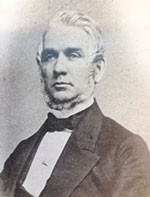 Charles Bingley Hall was born in Orford, New Hampshire, to a wealthy farming family on June 28, 1815. He began working as a clerk in Haverhill, Massachusetts, after finishing his primary education and briefly teaching elementary school in Oxford, Massachusetts. In 1838, Hall went into business as a self-employed salesman of general and “West-India goods.”
Charles Bingley Hall was born in Orford, New Hampshire, to a wealthy farming family on June 28, 1815. He began working as a clerk in Haverhill, Massachusetts, after finishing his primary education and briefly teaching elementary school in Oxford, Massachusetts. In 1838, Hall went into business as a self-employed salesman of general and “West-India goods.”
In 1841, he was appointed U.S. Postmaster of Haverhill, Massachusetts, a post that he kept for 8 years before being elected a Massachusetts legislative representative. As a Democrat he was a minority, but the position garnered him much respect and distinction. During this time, Hall also served as a trial justice for Essex County and as director of two Haverhill Banks (Merrimac Savings Bank and Haverhill Savings Bank). From there, he climbed to the rank of Treasurer and Receiver General of Massachusetts. As State Treasurer, Hall was also tasked with acting as Treasurer of the Commissioners of the Massachusetts School Sinking Fund, Commissioner of the Public Lands of Massachusetts within the State of Maine, and Commissioner of Insurance. After a change in parties ended Hall’s political career, he took a job as a cashier at the National Bank of Boston before taking up presidency of the bank in 1878.
He passed away in Boston, Massachusetts, on May 8, 1883 after a severe stroke in June of the previous year.
Incorporators of the Massachusetts Institute of Technology, MIT Institute Archives and Special Collections, c.1920, pg. 24
New England Historic Genealogical Register vol 38, pg. 91
“Proceedings of the Scottish Rite (Masonic order). Supreme Council for the Northern Jurisdiction,” Office of the Freemason’s Magazine, 1883, pg. 199
Augustus Allen Hayes
 Augustus Allen Hayes, a member of the original MIT Corporation, was born on February 28, 1806, in Windsor, Vermont. After graduating from the Norwich Military Academy in Vermont in 1823, Hayes took on an assistant professorship in the chemistry department of New Hampshire Medical College. During his career he studied and published widely on industrial chemistry. Most notable were his discoveries regarding processes for refining copper, iron, and saltpeter. In 1837, Hayes also conducted an investigation into the economization of steam production and fuel use, resulting in his invention of a more efficient steam boiler—widely adopted in the U.S. by the late 1830s.
Augustus Allen Hayes, a member of the original MIT Corporation, was born on February 28, 1806, in Windsor, Vermont. After graduating from the Norwich Military Academy in Vermont in 1823, Hayes took on an assistant professorship in the chemistry department of New Hampshire Medical College. During his career he studied and published widely on industrial chemistry. Most notable were his discoveries regarding processes for refining copper, iron, and saltpeter. In 1837, Hayes also conducted an investigation into the economization of steam production and fuel use, resulting in his invention of a more efficient steam boiler—widely adopted in the U.S. by the late 1830s.
Hayes was also a member of the Boston Thursday Evening Club, a men’s club founded in Boston in 1846 to promote social and scientific conversation. The records of the Boston Thursday Evening Club are held at the Massachusetts Historical Society. Hayes passed away in Brookline, Massachusetts, on June 21, 1881.
Incorporators of the Massachusetts Institute of Technology, MIT Institute Archives and Special Collections, c.1920, pg. 25
Proceedings of the American Academy of Arts and Sciences, vol. 18 (1882-1883), pp. 422-427 via JSTOR
Boston Thursday Evening Club Records, Massachusetts Historical Society
John Trull Heard
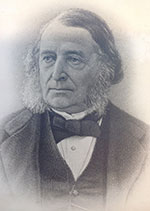 John Trull Heard was born on May 4, 1809, in Boston, Massachusetts. For the first 50 years of his adult life, he worked as a distiller for the firm Trull and Heard, which later became Heard and Welch. Having amassed a fortune from his business, he retired early and became a “distinguished citizen of Boston.” Although he was financially unable to pursue a college education as a young man, he kept up a lifelong study of both languages and political economy. These studies allowed him to publish several news articles on currency, banking, suffrage, insurance, and taxes. He also published a history of the Columbian Lodge of the Freemasons.
John Trull Heard was born on May 4, 1809, in Boston, Massachusetts. For the first 50 years of his adult life, he worked as a distiller for the firm Trull and Heard, which later became Heard and Welch. Having amassed a fortune from his business, he retired early and became a “distinguished citizen of Boston.” Although he was financially unable to pursue a college education as a young man, he kept up a lifelong study of both languages and political economy. These studies allowed him to publish several news articles on currency, banking, suffrage, insurance, and taxes. He also published a history of the Columbian Lodge of the Freemasons.
Although he was a Democrat, during the Civil War he “threw off all party ties” and aligned himself wholeheartedly with the Union, even relocating to Washington so as to devote more of his time and resources to the cause.
In the years following his retirement, Heard also kept up with political and social ventures. He served as the Commissioner of the Cochituate Water Board and as the Director of the Boston House of Industry. In 1853, President-Elect Franklin Pierce offered him a position as Sub-Treasurer of Boston, but he rejected it. However, he did act as an advisor to President Abraham Lincoln a few years later. Heard was also a longtime member of the Freemasons and the New England Historic Genealogical Society. He passed away in Boston, Massachusetts, on December 1, 1880.
Incorporators of the Massachusetts Institute of Technology, MIT Institute Archives and Special Collections, c.1920, pg. 26
“Proceedings of the Grand Lodge of MA” 1881-1882, p.14
In memoriam, 1880, Massachusetts Historical Society
Memorial Biographies of the New England Historic Genealogical Society, NEHGS, 1907, pg. 19
Sidney Homer
Sidney Homer was born in Boston, Massachusetts, on April 19, 1810. Along with his brother Peter, Homer earned his fortune working for Adams, Homer, and Co., a Boston importing firm. He retired from business by 1850, but continued to pursue his interests in education and free trade afterward. Homer acted as a trustee to several properties around Boston and spent his spare time traveling in Europe. He also acted as president of the Massachusetts Charitable Society from 1862-1866. After his death, Homer left $2,000 to the Massachusetts Institute of Technology for the purpose of funding lectures on science given by graduates of the Institute.
Incorporators of the Massachusetts Institute of Technology, MIT Institute Archives and Special Collections, c.1920, pg. 28 (“Compiled from various sources of information”)
Eben Norton Horsford
 Born in Moscow, New York, on January 27, 1818, Eben Horsford dedicated his life to science and academia. A distinguished chemist, Horsford specialized in the chemistry of food—with a special interest in bread. His work in this area was especially influential on the processes involved in the manufacture of baking powder and condensed milk. Today he is touted as the “father of American food technology.”
Born in Moscow, New York, on January 27, 1818, Eben Horsford dedicated his life to science and academia. A distinguished chemist, Horsford specialized in the chemistry of food—with a special interest in bread. His work in this area was especially influential on the processes involved in the manufacture of baking powder and condensed milk. Today he is touted as the “father of American food technology.”
He graduated from Rensselaer Polytechnic Institute in 1837, and received honorary degrees later on from Harvard, Castleton Medical College, and Union College. After his graduation, Horsford took up teaching, becoming Professor of Mathematics and Natural Sciences at Albany Female Academy. He took a hiatus to study chemistry in Germany under Baron von Liebig, the famous biological and agricultural chemist, before returning to Boston in 1847. From there, he took up the Rumford Professorship in applied science at Harvard, a position which he held for 16 years. Horsford spent the last year of his career as a professor as the Dean of Lawrence Scientific School from 1861-1862.
In addition to the sciences, Horsford was also an advocate for women’s education. He was a beloved benefactor of Wellesley College and was active in its management, becoming president of the board of visitors and donating generously throughout his life. On January 1, 1893, Horsford passed away in Cambridge, Massachusetts.
Incorporators of the Massachusetts Institute of Technology, MIT Institute Archives and Special Collections, c.1920, pg. 29
“Universities and their Sons” vol.2, p.382
Personal papers at RPI Archives
Theodore Russell Jencks
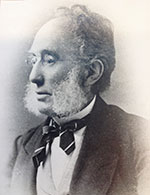 Theodore Russell Jencks, or “T. Russell Jencks,” was born on December 25, 1801, in Bath, Maine. He attended Harvard at just 14 years old, earning his diploma in 1821. Although he was a lawyer by trade, he devoted much of his time and energy to the cause of education. At Mount Hope College in Maryland, Jencks acted as Professor of Political Literature, English Language and Literature, and Ancient Language and Literature. He also wrote extensively on the application of manual and industrial education in the U.S. before it had been widely adopted, deriving much of his information from practices he saw in Europe. Jencks passed away in Ocean Beach, New Jersey, on September 8, 1883.
Theodore Russell Jencks, or “T. Russell Jencks,” was born on December 25, 1801, in Bath, Maine. He attended Harvard at just 14 years old, earning his diploma in 1821. Although he was a lawyer by trade, he devoted much of his time and energy to the cause of education. At Mount Hope College in Maryland, Jencks acted as Professor of Political Literature, English Language and Literature, and Ancient Language and Literature. He also wrote extensively on the application of manual and industrial education in the U.S. before it had been widely adopted, deriving much of his information from practices he saw in Europe. Jencks passed away in Ocean Beach, New Jersey, on September 8, 1883.
Incorporators of the Massachusetts Institute of Technology, MIT Institute Archives and Special Collections, c.1920, pg. 30 (biographical information “from memoranda furnished by his daughter, Mrs. Florence Cairns”)
Charles Nowell
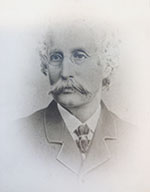 Charles Nowell was born in York, Maine, on June 7, 1817. Although he was educated by a Harvard tutor as a young man, he never received a formal college degree. After studying under an architect in Boston, Nowell became a builder by trade and co-founded the George and Charles Nowell architectural firm with his brother. Throughout his career, Nowell constructed many buildings on St. James Avenue in Boston, Massachusetts. He also assisted in rebuilding the “burnt district” after the Great Boston Fire of 1872.
Charles Nowell was born in York, Maine, on June 7, 1817. Although he was educated by a Harvard tutor as a young man, he never received a formal college degree. After studying under an architect in Boston, Nowell became a builder by trade and co-founded the George and Charles Nowell architectural firm with his brother. Throughout his career, Nowell constructed many buildings on St. James Avenue in Boston, Massachusetts. He also assisted in rebuilding the “burnt district” after the Great Boston Fire of 1872.
Nowell was very interested in the establishment of MIT and played an active role, especially in choosing the original Boylston Street location and in the establishment of a Department of Architecture. During the Civil War, Nowell served as Commissioner for Clothing for the City of Boston. Earlier in his career he also served as Assessor of Ward II in Boston and was a member of the Boston Common Council (1855) and the Massachusetts House of Representatives (1856-1858). Nowell passed away in Boston, Massachusetts, on August 10, 1901.
Incorporators of the Massachusetts Institute of Technology, MIT Institute Archives and Special Collections, c.1920, pg. 32 (biographical information from daughter Charlotte E. Nowell)
George Odiorne
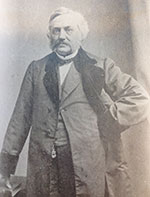 Born in Malden, Massachusetts, on July 31, 1815, George Odiorne began as a businessman in the iron and real estate industries. He took his iron business to the South, making many prominent connections, but returned to the East Coast just before the Civil War began. From there, Odiorne became active in municipal and state politics. He was Boston Alderman in 1854, and represented Suffolk County in the Massachusetts Senate from 1859 to 1860. During his work as a statesman Odiorne helped push several bills concerning the improvement of the City of Boston through the Senate, including the movement to fill in the Back Bay. This tangentially led to the establishment of MIT’s location there. On November 18, 1892, George Odiorne passed away in Boston, Massachusetts.
Born in Malden, Massachusetts, on July 31, 1815, George Odiorne began as a businessman in the iron and real estate industries. He took his iron business to the South, making many prominent connections, but returned to the East Coast just before the Civil War began. From there, Odiorne became active in municipal and state politics. He was Boston Alderman in 1854, and represented Suffolk County in the Massachusetts Senate from 1859 to 1860. During his work as a statesman Odiorne helped push several bills concerning the improvement of the City of Boston through the Senate, including the movement to fill in the Back Bay. This tangentially led to the establishment of MIT’s location there. On November 18, 1892, George Odiorne passed away in Boston, Massachusetts.
Incorporators of the Massachusetts Institute of Technology, MIT Institute Archives and Special Collections, c.1920, pg. 33 (biographical information from a Boston obituary notice)
Odiorne Family genealogy, Massachusetts Historical Society
Joel Parker
 Joel Parker was born in Jaffrey, New Hampshire, on January 25, 1795. He was a scholar of law; after graduating from Dartmouth and passing the Bar in 1811, he received L.L.D.s from both Dartmouth and Harvard. Parker took an active role in the government of his home state of New Hampshire. He served on the supreme bench of New Hampshire in 1833 and as Chief Justice in 1836, and was involved in the revision of the state’s public statutes in 1840. He also published extensively on law, government, and ethics.
Joel Parker was born in Jaffrey, New Hampshire, on January 25, 1795. He was a scholar of law; after graduating from Dartmouth and passing the Bar in 1811, he received L.L.D.s from both Dartmouth and Harvard. Parker took an active role in the government of his home state of New Hampshire. He served on the supreme bench of New Hampshire in 1833 and as Chief Justice in 1836, and was involved in the revision of the state’s public statutes in 1840. He also published extensively on law, government, and ethics.
Although he was generally conservative, Parker was a staunch supporter of the cause of antislavery and published writings on the topic. His wife, Mary Morse Parker, was a schoolteacher who spent nights teaching escaped slaves. Parker himself was unable to fight in the Civil War due to his age, but was so dedicated to the union effort that he spent his spare time and money sewing new uniforms for the local U.S. army companies.
Starting in 1847, Parker took on professorships at Dartmouth and Harvard. He retained his title of Professor of Medical Jurisprudence at Dartmouth until 1857 and Royal Professor of Law at Harvard until 1868. He was also a member of the American Academy of Arts and Sciences and the Massachusetts Historical Society. On August 18, 1875, Parker passed away in Boston, Massachusetts. His personal papers, including a family genealogy with anecdotes written by his daughter, are available at the Massachusetts Historical Society. His business records are housed at Harvard.
Incorporators of the Massachusetts Institute of Technology, MIT Institute Archives and Special Collections, c.1920, pg. 34
Joel Parker Papers, Massachusetts Historical Society (incl. “three true tales” by Mary Gertrude Parker Sheffield)
“Universities and their Sons” vol. 2 pg. 326
Joel Parker business records and estate papers, Harvard University
William Pearce Parrott
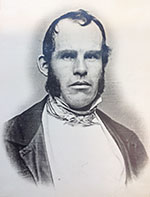 William Pearce Parrott was born in Gloucester, Massachusetts, on March 2, 1810. He attended Dummer Academy (now the Governor’s Academy) in South Byfield, Massachusetts, around 1819 before becoming a cadet at the American Literary, Scientific, and Military Academy (now Norwich University), in Vermont. Parrott graduated from the academy in 1825.
William Pearce Parrott was born in Gloucester, Massachusetts, on March 2, 1810. He attended Dummer Academy (now the Governor’s Academy) in South Byfield, Massachusetts, around 1819 before becoming a cadet at the American Literary, Scientific, and Military Academy (now Norwich University), in Vermont. Parrott graduated from the academy in 1825.
As a civil engineer in Boston, Massachusetts, Parrott became chief engineer of the Boston and Lowell Railroad. He also acted as Secretary of the New England Association of Railroad Superintendents and as President of the Vermont and Canada Railroad. In 1849, Parrott was commissioned along with E.S. Cheseborough to refine Charles Bulfinch’s plan for Boston’s South End, which began construction within the year. Later in life Parrott was also a member of the Massachusetts Charitable Mechanics Association (1856-1868) and the Boston Society for Civil Engineers (1848). The State Library of Massachusetts holds a few documents regarding the Massachusetts Board of Railroad Commissioners authored by Parrott. He passed away in Boston, Massachusetts, on March 4, 1868.
Incorporators of the Massachusetts Institute of Technology, MIT Institute Archives and Special Collections, c.1920, pg. 35 (Bio from daughter, Louisa P. Russell)
Ellis, William Arba, Norwich University, 1819-1911; Her History, Her Graduates, Her Roll of Honor, vol. 2, pg. 189
Massachusetts State Library
Benjamin Peirce
 Benjamin Peirce, a Mathematician and Harvard Professor, was born on April 4, 1809, in Salem, Massachusetts. After graduating from Harvard in 1829, Peirce became University Professor of Mathematics and Natural Philosophy there. He also took on the Perkins Professorship of Astronomy and Mathematics in 1842. As a professor, Peirce published several textbooks on geometry, trigonometry, algebra, and more. He is best known for Peirce’s Criterion, a statistical method relating to the treatment of outliers, as well as for coining the phrase “mathematics is the science that draws necessary conclusions.” A small lunar crater was also named in his honor. Following the Great Comet of 1843, public interest in the study of astronomy rose greatly. This allowed Peirce to successfully push for the foundation of Harvard’s Astronomical Observatory.
Benjamin Peirce, a Mathematician and Harvard Professor, was born on April 4, 1809, in Salem, Massachusetts. After graduating from Harvard in 1829, Peirce became University Professor of Mathematics and Natural Philosophy there. He also took on the Perkins Professorship of Astronomy and Mathematics in 1842. As a professor, Peirce published several textbooks on geometry, trigonometry, algebra, and more. He is best known for Peirce’s Criterion, a statistical method relating to the treatment of outliers, as well as for coining the phrase “mathematics is the science that draws necessary conclusions.” A small lunar crater was also named in his honor. Following the Great Comet of 1843, public interest in the study of astronomy rose greatly. This allowed Peirce to successfully push for the foundation of Harvard’s Astronomical Observatory.
Peirce involved himself in the Civil War only to a minor degree, instead focusing wholeheartedly on the advancement of math and science. In fact, Peirce is said to have deemed slavery acceptable if used to free intellectual elites for the purpose of scientific inquiry, as was the custom in Ancient Greece. Peirce did, however, contribute to the war effort in small ways including working for the U.S. Sanitary Commission and suggesting to the City of Boston ideas for the defense of Boston Harbor.
Later in life, Peirce served as an Assistant Astronomer for the American Ephemeris and Nautical Almanac and as Superintendent of the U.S. Coast Guard Survey. He passed away in Cambridge, Massachusetts, on October 6, 1880. After his death, Oliver Wendell Holmes dedicated a poem to his memory. Peirce’s personal papers, mostly consisting of correspondence, are housed at Harvard.
Incorporators of the Massachusetts Institute of Technology, MIT Institute Archives and Special Collections, c.1920, pg. 36
Universities & their Sons vol. 2, pg. 228
Auspitz, Josiah Lee, “The Wasp Leaves the Bottle: Charles Sanders Peirce,” The American Scholar, vol. 63 (4), pg. 602–618
Benjamin Peirce correspondence, circa 1835-1880, Harvard University
“Benjamin Peirce: Astronomer, Mathematician. 1809-1880,” poem, Oliver Wendell Holmes
John Dudley Philbrick
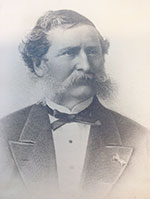 An original member of the MIT Corporation, John Dudley Philbrick was born in Deerfield, New Hampshire, on May 28, 1818. He graduated from Dartmouth in 1842, and later received honorary Ph.D., L.L.D., and D.C.L. degrees from Dartmouth, Bates, and the University of St. Andrews, respectively.
An original member of the MIT Corporation, John Dudley Philbrick was born in Deerfield, New Hampshire, on May 28, 1818. He graduated from Dartmouth in 1842, and later received honorary Ph.D., L.L.D., and D.C.L. degrees from Dartmouth, Bates, and the University of St. Andrews, respectively.
A lifelong practitioner and advocate of education, Philbrick began his career as a teacher at the Roxbury Latin School between 1842 and 1844. He was a co-founder of the Quincy Grammar School, the first school in the United States to separate its students by grade level. Philbrick remained schoolmaster there for 8 years. His teaching career ended with a stint as Principal of the Connecticut Normal School.
After that, Philbrick served as Superintendent of Boston and Connecticut schools as well as President of the Teachers Association of Connecticut in 1851, the American Institute of Instruction in 1858, the National Teachers Association in 1862, and the Massachusetts Teachers Association in 1864. He also acted as U.S. Commissioner of Education during the Paris Exposition of 1878, where he was awarded the decoration of the Legion of Honor. He passed away in Danvers, Massachusetts, on February 2, 1886.
Incorporators of the Massachusetts Institute of Technology, MIT Institute Archives and Special Collections, c.1920, pg. 37
Dunton, Larkin, A memorial of the life and services of John D. Philbrick, New England Publishing, 1888
Carlos Pierce
 Carlos Pierce was born in Stanstead, Quebec, Canada, on May 20, 1831. He maintained a lifelong devotion to his hometown, returning often to participate in city planning and to act as a benefactor. His contributions to Stanstead included, among others, a race course and a fairground.
Carlos Pierce was born in Stanstead, Quebec, Canada, on May 20, 1831. He maintained a lifelong devotion to his hometown, returning often to participate in city planning and to act as a benefactor. His contributions to Stanstead included, among others, a race course and a fairground.
As a young man, Pierce relocated to Boston, Massachusetts, to work for the dry goods firm Dutton, Richardson, and Co. In 1848 one of the company’s buildings collapsed while Pierce was inside, leaving him buried for 5 hours but virtually unharmed. Pierce left the company in 1851 to co-found his own dry goods company, Peirce Brothers and Flanders, which became just Pierce Brothers and Co. soon after. By 1863 Pierce had amassed enough money to retire from business completely, after which he became a “gentleman farmer.”
Later in life, Pierce attempted to use some of his fortune to purchase and develop land in Kansas, hoping to develop a railroad by charter. The stress of this venture was too much for Pierce, who passed away at just 39 years old on August 20, 1870, in his hometown of Stanstead.
Incorporators of the Massachusetts Institute of Technology, MIT Institute Archives and Special Collections, c.1920, pg. 38 (bio from Pierce Genealogy, Worcester 1882)
Lawrence, John, Forests and Clearings: The History of Stanstead County, Province of Quebec, with Sketches of More Than Five Hundred Families, Heritage Books, 1988
Jonathan Preston
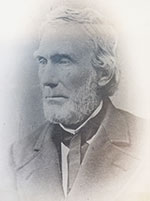 Jonathan Preston was born on July 14, 1801, in Beverly, Massachusetts. An eventual member of the MIT Corporation, he came from humble beginnings as a stonemason in Boston, Massachusetts. This blossomed into a successful career as an architect, during which Preston designed many notable buildings including the Boston Theater, the United States Hotel, the Boston Society for Natural History, and the Rogers Building at MIT’s original campus in Boston’s Back Bay. He also served as contractor during the construction of the Massachusetts Eye and Ear Infirmary in 1849.
Jonathan Preston was born on July 14, 1801, in Beverly, Massachusetts. An eventual member of the MIT Corporation, he came from humble beginnings as a stonemason in Boston, Massachusetts. This blossomed into a successful career as an architect, during which Preston designed many notable buildings including the Boston Theater, the United States Hotel, the Boston Society for Natural History, and the Rogers Building at MIT’s original campus in Boston’s Back Bay. He also served as contractor during the construction of the Massachusetts Eye and Ear Infirmary in 1849.
Throughout his life Preston spent time as a member of the Massachusetts Senate and House of Representatives, as well as the Boston Water Board. He also served as Boston Alderman (1843-1861), and Chairman of the Commission for the Development of Back Bay Lands. The latter position allowed him to aid in MIT’s acquisition of its original Back Bay location. Preston was quite invested in the establishment of MIT, and ended up greatly helping to make it a reality by securing a large donation toward its creation from Ralph Huntington, a wealthy Bostonian.
Preston passed away in Boston, Massachusetts, on July 3, 1888. For a detailed exploration of the construction of MIT’s Rogers Building, see chapter 14 of Mind and Hand: The Birth of MIT by Julius Stratton and Loretta H. Mannix.
Incorporators of the Massachusetts Institute of Technology, MIT Institute Archives and Special Collections, c.1920, pg. 39 (bio from his son, George Preston)
“The Rogers Building, Boston, 1866-1938,” MIT Libraries Object of the Month, April 2007
Mind and Hand: The Birth of MIT, MIT Press, 2005, Chapter 14
Edward Samuel Ritchie
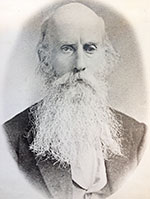 Edward Samuel Ritchie was born in Dorchester, Massachusetts, on August 18, 1814. As the only surviving child of a family of six, Ritchie’s parents gave him every advantage and did their best to foster his scientific and artistic proclivities, although his weak health prevented him from attending college. In 1850, he went into the philosophical instrument business, developing air pumps, image plates, and other tools of scientific demonstration and experimentation. Soon after 1850, Ritchie’s improvement of the Ruhmkorff induction coil brought him into the public eye. After Ritchie published his findings in an American journal, Heinrich Ruhmkorff, the original inventor of the induction coil, took Ritchie’s plans to Paris and presented them as his own. The design was so much improved that Ruhmkorff won a prize that should have rightfully belonged to Ritchie. Fortunately, this did not do much to tarnish Ritchie’s reputation or zest for invention.
Edward Samuel Ritchie was born in Dorchester, Massachusetts, on August 18, 1814. As the only surviving child of a family of six, Ritchie’s parents gave him every advantage and did their best to foster his scientific and artistic proclivities, although his weak health prevented him from attending college. In 1850, he went into the philosophical instrument business, developing air pumps, image plates, and other tools of scientific demonstration and experimentation. Soon after 1850, Ritchie’s improvement of the Ruhmkorff induction coil brought him into the public eye. After Ritchie published his findings in an American journal, Heinrich Ruhmkorff, the original inventor of the induction coil, took Ritchie’s plans to Paris and presented them as his own. The design was so much improved that Ruhmkorff won a prize that should have rightfully belonged to Ritchie. Fortunately, this did not do much to tarnish Ritchie’s reputation or zest for invention.
During the Civil War, Ritchie worked to improve on the current design for a nautical compass in order to aid the U.S. Navy. By the end of his work he had invented the liquid compass and the theodolite, both of which were extremely helpful to the Navy. Ritchie Navigation, originally E.S. Ritchie and Sons, still manufactures compasses and other oceanic navigational tools to this day. Ritchie passed away in Newton, Massachusetts, on June 1, 1895. A biography of Ritchie can be found in the Proceedings of the American Academy of Arts and Sciences, of which he was a member. Instruments constructed and invented by Ritchie are held at Harvard.
Incorporators of the Massachusetts Institute of Technology, MIT Institute Archives and Special Collections, c.1920, pg. 41 (from information given by daughter)
“Edward Samuel Ritchie,” Proceedings of the American Academy of Arts and Sciences, vol. 31
Related holdings at Harvard
www.ritchienavigation.com
John Daniel Runkle
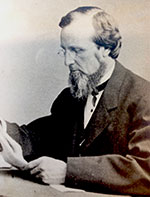 John Daniel Runkle, the second president of MIT, was born in Root, New York, on October 11, 1822. Poor health and obligation to his parents’ farm kept him from college until age 25, after which he was part of the first graduating class of the Lawrence Scientific School at Harvard in 1851. Later, he received an honorary M.A. and Ph.D. from Hamilton College in 1867 and an honorary L.L.D. from Wesleyan in 1871.
John Daniel Runkle, the second president of MIT, was born in Root, New York, on October 11, 1822. Poor health and obligation to his parents’ farm kept him from college until age 25, after which he was part of the first graduating class of the Lawrence Scientific School at Harvard in 1851. Later, he received an honorary M.A. and Ph.D. from Hamilton College in 1867 and an honorary L.L.D. from Wesleyan in 1871.
Throughout his life Runkle published articles on mathematics in the American Ephemeris and Nautical Almanac and was connected with the Smithsonian. He was also a member of the American Academy of Arts and Sciences, the American Association for the Advancement of Science, the American Social Science Association, the New England Historic Genealogical Society, and the Society of Arts of the Massachusetts Institute of Technology.
Dedicated to the study of mathematics and astronomy, Runkle was closely involved with MIT’s founding and establishment. He became its first Professor of Mathematics in 1865, and took on the role of President of the Institute in 1870. After resigning several years later to travel, Runkle returned to MIT as a mathematics professor and remained until his death. He passed away in Southwest Harbor, Maine, on July 8, 1902. His papers can be found at the MIT Institute Archives and Special Collections.
Incorporators of the Massachusetts Institute of Technology, MIT Institute Archives and Special Collections, c.1920, pg. 45
Tyler, Harry Walker, John Daniel Runkle, 1822-1902: a memorial, Geo H. Ellis and Co., 1902
Papers of John D. Runkle, MIT Archives and Special Collections
Nathaniel Bradstreet Shurtleff
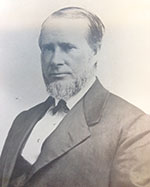 Nathaniel Bradstreet Shurtleff was born in Boston, Massachusetts, on June 29, 1810. He graduated from Harvard in 1831, and Harvard Medical School in 1834. He also received the M.A. degrees from Harvard, Brown, and the University of Illinois. He was a trustee of the Boston Public Library and the first-ever Democrat to be elected mayor of the City of Boston. His successful election as a Democrat in 1867 came after a previous loss when he ran for mayor as a Know-Nothing candidate in 1855.
Nathaniel Bradstreet Shurtleff was born in Boston, Massachusetts, on June 29, 1810. He graduated from Harvard in 1831, and Harvard Medical School in 1834. He also received the M.A. degrees from Harvard, Brown, and the University of Illinois. He was a trustee of the Boston Public Library and the first-ever Democrat to be elected mayor of the City of Boston. His successful election as a Democrat in 1867 came after a previous loss when he ran for mayor as a Know-Nothing candidate in 1855.
Although Shurtleff was a medical doctor by trade, much of his focus was devoted to politics and history. In pursuit of his passion for genealogy and early U.S. history, Shurtleff studied and published records of the Massachusetts Bay Colony as well as a “Topographical and Historical Description of Boston.” He also traced his own family back to eleven pilgrims on the Mayflower and wrote a detailed genealogical description of his family. This description includes an especially gruesome account of the death of one of his ancestors whose house was struck by lightning. Shurtleff passed away in Dorchester, Massachusetts, on October 17, 1874.
Incorporators of the Massachusetts Institute of Technology, MIT Institute Archives and Special Collections, c.1920, pg. 46
Shurtleff, Nathaniel, Descendants of William Shurtleff of Plymouth and Marshfield, Massachusetts, 1912
Assorted papers relating to mayoral race, Massachusetts Historical Society
James Slade
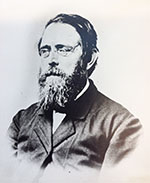 James Slade was born in Boston, Massachusetts, on March 26, 1816. As a young man he began training as a carpenter, but soon decided to pursue a profession in civil engineering out of personal preference. He received no formal training, instead studying civil engineering independently and working hard to develop his skills. By 1855, he was a city engineer of Boston, Massachusetts, having established a good reputation for himself. He retained the position for 8 years, during which he oversaw the extension of Boston’s water system into the new Back Bay lands. In addition, Slade served as a consulting engineer to the city water departments of Baltimore, Maryland, Hartford, Connecticut, Washington, D.C., and others. He was also a member of the Massachusetts Charitable Mechanics Association. Slade passed away in Roslindale, Massachusetts, on August 25, 1882.
James Slade was born in Boston, Massachusetts, on March 26, 1816. As a young man he began training as a carpenter, but soon decided to pursue a profession in civil engineering out of personal preference. He received no formal training, instead studying civil engineering independently and working hard to develop his skills. By 1855, he was a city engineer of Boston, Massachusetts, having established a good reputation for himself. He retained the position for 8 years, during which he oversaw the extension of Boston’s water system into the new Back Bay lands. In addition, Slade served as a consulting engineer to the city water departments of Baltimore, Maryland, Hartford, Connecticut, Washington, D.C., and others. He was also a member of the Massachusetts Charitable Mechanics Association. Slade passed away in Roslindale, Massachusetts, on August 25, 1882.
Incorporators of the Massachusetts Institute of Technology, MIT Institute Archives and Special Collections, c.1920, pg. 47
Annals of the Charitable Mechanics Association, pg. 348
George William Tuxbury
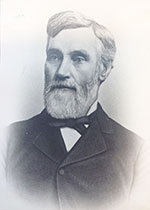 A member of the MIT Corporation, George William Tuxbury was born on November 8, 1822, in Salisbury, Massachusetts, where he grew up on his family’s farm. After graduating from Dartmouth as class orator in 1845, Tuxbury took up the study of law in the office of Hubbard and Wells in Boston, Massachusetts. He passed the Bar in 1848. As a practicing lawyer, his most prominent case was that of Isaac S. Burrell v. the City of Boston in his claim for services rendered during the Civil War. The case lasted for 25 years.
A member of the MIT Corporation, George William Tuxbury was born on November 8, 1822, in Salisbury, Massachusetts, where he grew up on his family’s farm. After graduating from Dartmouth as class orator in 1845, Tuxbury took up the study of law in the office of Hubbard and Wells in Boston, Massachusetts. He passed the Bar in 1848. As a practicing lawyer, his most prominent case was that of Isaac S. Burrell v. the City of Boston in his claim for services rendered during the Civil War. The case lasted for 25 years.
In his thirties, Tuxbury developed a condition causing deafness which forced him to retire from the courtroom and focus on office work. This did not deter him from continuing the work he could still manage to do. He was a member of the Boston Common Council from 1857 to 1858, and a member of the Boston School Committee from 1855 to 1857 and again from 1860 to 1865. He passed away in Boston, Massachusetts, on April 12, 1885.
Incorporators of the Massachusetts Institute of Technology, MIT Institute Archives and Special Collections, c.1920, pg. 49
“Professional and Industrial History of Suffolk Co.,” vol. 1 pg. 504
Charles Eliot Ware
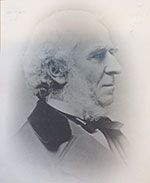 Charles Eliot Ware, a member of the MIT Corporation, was born in Cambridge, Massachusetts, on May 7, 1814. A physician by trade, he graduated from Harvard in 1834 and Harvard Medical School in 1837. After studying medicine in Europe, Ware returned to Boston, Massachusetts, and started a practice. After a ten year stint as a visiting physician at Massachusetts General Hospital, he was appointed to the consulting staff there in 1867.
Charles Eliot Ware, a member of the MIT Corporation, was born in Cambridge, Massachusetts, on May 7, 1814. A physician by trade, he graduated from Harvard in 1834 and Harvard Medical School in 1837. After studying medicine in Europe, Ware returned to Boston, Massachusetts, and started a practice. After a ten year stint as a visiting physician at Massachusetts General Hospital, he was appointed to the consulting staff there in 1867.
Ware also acted as Vice-President of the Boston Lying-In Hospital, Secretary of the Massachusetts Medical Society, and Secretary of the Boston Society for Medical Improvement. After his death on September 3, 1887, Ware’s wife and daughter financed the creation of the Blaschka Glass Flower Collection at Harvard in his honor. The collection is still viewable there today.
Incorporators of the Massachusetts Institute of Technology, MIT Institute Archives and Special Collections, c.1920, pg. 50
Obituary, Boston Medical and Surgical Journal, 1887
“Glass Flowers: The Ware Collection of Blaschka Glass Models of Plants,” Harvard Museum of Natural History
Levi Lincoln Willcutt
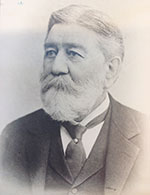 Levi Lincoln Willcutt was born in Boston, Massachusetts, on March 3, 1826. He first entered the workforce in 1841 under Craigin and Patterson, wholesale dry goods merchants. Later on he worked as a salesman for Blake, Patterson, and Co., merchants and importers of woolens. Willcutt left Boston for a few years to work with other such businesses across the East Coast before returning in 1853 to go into business for himself. The New England Roofing Company, which Willcutt established with two of his peers, was one of the first companies devoted to the manufacture of felt roofing materials. The company flourished, and Willcutt served there for over 40 years—first as an agent, then as Treasurer, and finally as President before retiring from the business in 1911.
Levi Lincoln Willcutt was born in Boston, Massachusetts, on March 3, 1826. He first entered the workforce in 1841 under Craigin and Patterson, wholesale dry goods merchants. Later on he worked as a salesman for Blake, Patterson, and Co., merchants and importers of woolens. Willcutt left Boston for a few years to work with other such businesses across the East Coast before returning in 1853 to go into business for himself. The New England Roofing Company, which Willcutt established with two of his peers, was one of the first companies devoted to the manufacture of felt roofing materials. The company flourished, and Willcutt served there for over 40 years—first as an agent, then as Treasurer, and finally as President before retiring from the business in 1911.
Willcutt was also a member of the Mercantile Library Association and the Boston Common Council, as well as an Overseer of the Poor in Boston from 1878-1885. He was the 8th President of the Old School Boys’ Association of Boston as well as the Eliot School Association. He also acted as Director of the Bostonian Society, the Boston Art Club, and the Revere House Corporation. He was a longtime member of many organizations including the Republican Institution of Boston, the Bunker Hill Monument Association, the New England Historic Genealogical Society, and the Massachusetts Horticultural Society, as well as social clubs such as the Masonic Fraternity and the Algonquin, Norfolk, and Middlesex Clubs. Willcutt passed away at his home in Brookline, Massachusetts, on January 3, 1912.
Incorporators of the Massachusetts Institute of Technology, MIT Institute Archives and Special Collections, c.1920, pg. 52
“Schools and Schoolboys of Boston” pg. 220
Henry Williams
 Henry Williams was born in Boston, Massachusetts, on April 24, 1816. He did well as a student at Harvard, graduating in 1837 with a Boylston Prize, the title of Class Secretary, and a membership with Phi Beta Kappa.
Henry Williams was born in Boston, Massachusetts, on April 24, 1816. He did well as a student at Harvard, graduating in 1837 with a Boylston Prize, the title of Class Secretary, and a membership with Phi Beta Kappa.
Following his graduation, Williams taught briefly at a few schools in the Boston area before taking on the position of Schoolmaster of Boston’s Winthrop School for Girls in 1837. He continued working for the Winthrop School network for the next 18 years. In 1851, Williams opened his own private school for girls, the Union Park School for Young Ladies in Boston. The school closed after only 30 years.
Throughout his life Williams was a member of the Colonial Society of Massachusetts as well as the New England Historic Genealogical Society. In 1887 he aided in the creation of the first ever Harvard Class Reports, compiling biographies of every member of the former class of 1837. Williams passed away in Boston, Massachusetts, on March 5, 1901.
Incorporators of the Massachusetts Institute of Technology, MIT Institute Archives and Special Collections, c.1920, pg. 53
Stiegler’s Educational Directory
Harvard College (1780- ). Class of 1837. Class Book, 1837-1900, Harvard University Archives
